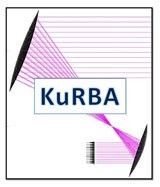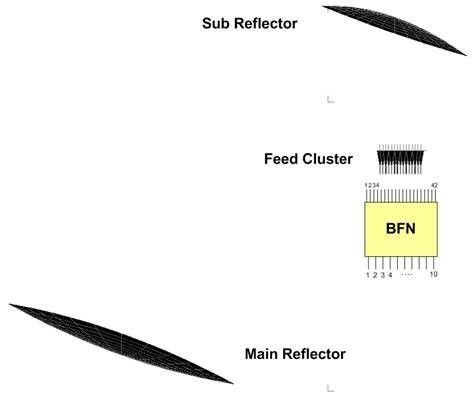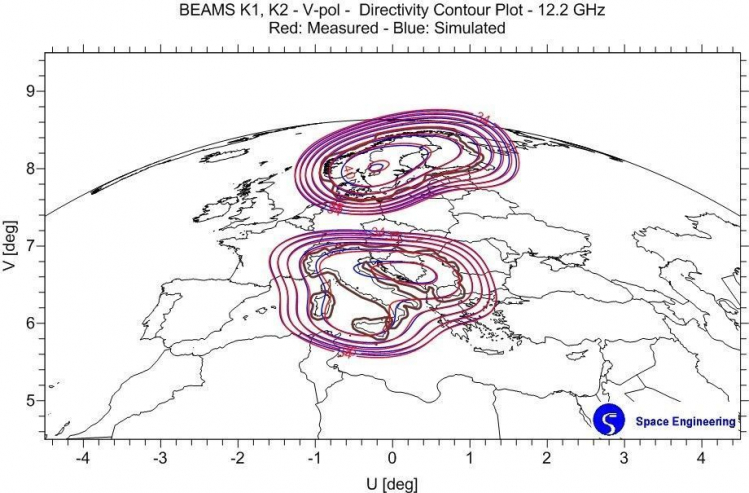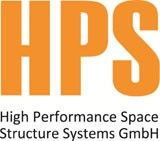
-
StatusOngoing
-
Status date2014-12-17
The objective of this project is the design of a full in-flight reconfigurable Ku-band high power broadcast antenna with flexible power allocation, working on multiple-regional beams and continental beams coverage, with dual-polarization capability, to cope with changes in user demand over the satellite lifetime. Moreover the demonstration of the proposed concept is requested and implemented by means of the design, manufacturing and test of a critical part of the selected baseline architecture.
The main challenges tackled in this activity are the following:
- Design of an innovative full in-flight reconfigurable antenna system, minimizing operative risks using consolidated technology for space applications (i.e. antenna reflectors).
- Minimization of the number of controls, in order to reduce the antenna BFN and HPA section complexity.
- Control of antenna grating lobe contributions, considering feed array design technique based on sparse/aperiodic feed array configurations.
- Maximization of the system DC power efficiency, with the HPAs amplitude unbalance controlled in the RF antenna optimization loop.
- RF and mechanical design of the single horn of the feed cluster as antenna critical breadboarding, working on the entire operative band at both linear polarizations, with a very high radiation efficiency and a very compact envelope and mass.
- RF and mechanical design of the Confocal antenna Demonstrator, composed by an 1x42 amplitude/phase re-configurable low power BFN, the complete Feed Cluster of 42 rectangular feed horns with OMTs and the Confocal antenna sub-reflector.
- RF test with the designed and manufactured critical breadboarding and antenna Demonstrator.
The magnification capability of the designed Confocal antenna configuration allows to have an array-like behavior with large antenna aperture, but with small phased array dimension and a reduced number of array elements.
This characteristic allows to reduce mass, complexity and cost of the antenna, making easier the accommodation on satellite and the in-orbit deployment, maintaining all the excellent features in terms of reconfigurability and flexibility, typical of DRA antennas.
Moreover, also the operative risks are minimized using consolidated technology for space applications (i.e. antenna reflectors).
The designed Confocal antenna architecture, associated with sparse/aperiodic array feeding system, creates an innovative approach capable to fulfill the reconfigurable regional and continental coverage missions in Ku-band, with full array operation and then full reconfiguration capability, full power allocation flexibility and graceful degradation, minimizing the number of controls.
This antenna configuration represents a good compromise among typical antenna solutions considered for these applications, like AFR architectures and DRA architectures, as it allows to avoid some drawbacks that characterize these antenna solutions.
Moreover, a detailed comparison between the designed Confocal antenna configuration and an existing flight antenna solution for the same dual polarized multi-contoured beam applications in Ku-band has been carried out, showing the many advantages of the Confocal antenna architecture in terms reconfigurability, flexibility, reduced mass and envelope, with a comparable RF performance
The extended antenna trade-off activity led to an innovative solution for the antenna architecture consisting of an imaging confocal antenna configuration fed by an aperiodic feed array. The confocal antenna is an assembly of two confocal paraboloids which are used to magnify the aperture size of a small active phased array.
The designed Confocal antenna architecture foresees an antenna able to work in dual orthogonal linear polarization, for different satellite orbital positions, from 5°W to 30°E, exhibiting 9 re-configurable regional beams plus an European global beam for each polarization.
The baseline Confocal antenna optics configuration is shown in the picture below.
The proposed front-end architecture consists of an active array of 42 elements. Low-Power BFNs for each beam are foreseen, for both linear polarizations, to reconfigure the beam with phase shifters and variable attenuators. After the low power BFN and before the antenna feed cluster, the high-power amplification section is in charge of amplifying the signal level. TWTAs are considered as reference to maximize the overall efficiency of the system.
The selected Confocal antenna feed cluster is composed by 42 rectangular apertures, working at both linear polarizations, with an aperiodic array layout to spread/move away the grating lobe contributions, minimizing the number of controls.
The main driver factor in the design of the feed array for the optimized Confocal antenna configuration was in fact the minimization of the number of the feed elements, in order to reduce the related BFN and HPA sections complexity.
A dedicated software tool has been developed by Space Engineering to perform the detailed Confocal antenna RF performance optimizations. It is able to achieve, along with typical antenna goals like EOC and side-lobe levels, also goals involving directly the system power, like co-channel beam C/I, DC power consumption. The HPAs load unbalance is controlled in the optimization. This approach allows to constraint the HPAs amplitude unbalance within the assigned range, optimizing simultaneously all the low-power BFNs’ coefficients in amplitude and phase. The optimization results guarantee to set the operating points for all TWTAs at the same level, with a consequent benefit in terms of HPA efficiency and a significant reduction of the DC power consumption.
A detailed assessment of the overall antenna P/L Mass has been carried out, along with the detailed accommodation study of the overall system on the spacecraft, showing the feasibility of the proposed Confocal antenna configuration.
For what concerns the developed demonstrator hardware, the selected Confocal antenna Demonstrator is composed by a 1x42 amplitude/phase reconfigurable low power BFN, the complete Feed Cluster of 42 Rectangular Feed Horns with OMTs and the Confocal antenna sub-reflector.
The RF measurement results achieved with the complete KuRBA Demonstrator are really very good as compared with the simulations, in terms of RF performance values (Dir. EOC, XPD & SLL) and directivity contour plots. An example of the achieved directivity contour plots for 2 iso-channel beams are shown in the following picture.


The overall activities of this project have been split in two phases (Phase 1 and Phase 2), plus a CCN (CCN3).
The Phase 1, Phase 2 and CCN3 of the project have been carried out with the following milestones, with the related major achievements:
Phase1:
- KO (Kick-Off)
- BDR (Definition of Mission Scenario, Selection of baseline Antenna configuration and Definition of baseline Antenna Requirements)
- PDR (Antenna preliminary design and analysis, Sub-Systems identification and development plan, Demonstrator definition)
Phase 2:
- KO (Kick-Off)
- CDR (Critical Breadboarding design, manufacture and test, Antenna detailed RF analysis, Demonstrator detailed design)
- TRB (Demonstrator manufacture and RF test)
- FR (Final Review)
CCN3:
- KO (Kick-Off)
- PM (Additional RF test on KuRBA Demonstrator, further detailed analysis for different HPA load unbalances, grating lobes and scanning capability, comparison of the designed Confocal antenna with an existing satellite antenna solution)
- FR (Final Review)
All the activities foreseen for the Phase 1, the Phase 2 and the CCN3 of the contract have been carried out.
The RF measurement results achieved with the KuRBA Demonstrator are really very good as compared with the simulations. This very good agreement between analyses and measurements have been confirmed by also all the additional RF tests carried out in the frame of the CCN3 of the contract.
The effectiveness of the Confocal antenna approach, associated with sparse/aperiodic array feeding system, seems to be definitively demonstrated for reconfigurable regional/continental coverage missions in Ku-band.





